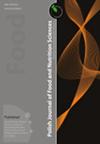Truffle Species Discrimination Based on Their Chemical Composition, Chromaticity Coordinates and Antioxidant Capacity
IF 2.3
4区 农林科学
Q3 FOOD SCIENCE & TECHNOLOGY
引用次数: 0
Abstract
Some edible truffle species are more sought after and expensive than others while they have a similar colour and appearance. This therefore leads to high risk of fraud. To prevent these frauds, this study proposes to explore the chemical composition and antioxidant capacity to discriminate the six-truffle species encountered in France. To achieve this, infrared spectrometry analysis, chromaticity measures and atomic absorption analysis were performed on dehydrated truffle powder as well as antioxidant capacity (ABTS and CUPRAC assays) and total phenolic content analyses were performed for truffle aqueous ethanol extracts. Infrared spectrometry analysis provided results allowing to discriminate the six-truffle species using a chitin/chitosan ratio (1,659 cm –1 /1,627 cm –1 ) determined in the range of 0.75 to 0.93 or a β/α-glucan ratio (889 cm –1 /850 cm –1 ) in the range from 1.50 to 1.81. Colour coordinates, including L *, a * and b * values, ranged from 20.56 to 36.35, 1.62 to 4.23 and 2.78 to12.9, respectively, and differed significantly between species. Truffle calcium and magnesium content was 2.62–0.48 mg/g dry weight and 0.91–0.21 mg/g dry weight, which also differentiated truffle species. Total phenolic content and antioxidant capacity analyses allowed to discriminate most of the six-truffle species but not each of the species. Thus, biophysical approaches and, to a lesser extent, the antioxidant activity assays, and total phenolic content are credible means of identifying truffle species found in France基于化学成分、色度坐标和抗氧化能力的松露品种鉴别方法
有些食用松露品种比其他品种更抢手、更昂贵,但它们的颜色和外观却很相似。这就导致了欺诈的高风险。为了防止这些欺诈行为,本研究建议探索化学成分和抗氧化能力,以区分在法国遇到的六种松露品种。为此,我们对脱水松露粉末进行了红外光谱分析、色度测量和原子吸收分析,并对松露乙醇水提取物进行了抗氧化能力(ABTS 和 CUPRAC 分析)和总酚含量分析。红外光谱分析结果表明,利用几丁质/壳聚糖比率(1,659 cm -1 /1,627 cm -1 )在 0.75 至 0.93 之间或 β/α-葡聚糖比率(889 cm -1 /850 cm -1 )在 1.50 至 1.81 之间的测定值,可以区分六种松露品种。颜色坐标(包括 L *、a * 和 b * 值)的范围分别为 20.56 至 36.35、1.62 至 4.23 和 2.78 至 12.9,不同品种之间差异显著。松露的钙和镁含量分别为 2.62-0.48 毫克/克(干重)和 0.91-0.21 毫克/克(干重),这也是松露物种之间的差异。总酚含量和抗氧化能力分析可以区分六种松露中的大多数种类,但不能区分每个种类。因此,生物物理方法以及在较小程度上的抗氧化活性测定和总酚含量是鉴别法国松露种类的可靠方法。
本文章由计算机程序翻译,如有差异,请以英文原文为准。
求助全文
约1分钟内获得全文
求助全文
来源期刊

Polish Journal of Food and Nutrition Sciences
FOOD SCIENCE & TECHNOLOGY-
CiteScore
4.30
自引率
12.50%
发文量
25
审稿时长
20 weeks
期刊介绍:
The Polish Journal of Food and Nutrition Sciences publishes original, basic and applied papers, reviews and short communications on fundamental and applied food research in the following Sections:
-Food Technology:
Innovative technology of food development including biotechnological and microbiological aspects
Effects of processing on food composition and nutritional value
-Food Chemistry:
Bioactive constituents of foods
Chemistry relating to major and minor components of food
Analytical methods
-Food Quality and Functionality:
Sensory methodologies
Functional properties of food
Food physics
Quality, storage and safety of food
-Nutritional Research Section:
Nutritional studies relating to major and minor components of food (excluding works related to questionnaire
surveys)
-“News” section:
Announcements of congresses
Miscellanea
 求助内容:
求助内容: 应助结果提醒方式:
应助结果提醒方式:


